
The cicadas are a superfamily, the Cicadoidea, of insects in the order Hemiptera. They are in the suborder Auchenorrhyncha, along with smaller jumping bugs such as leafhoppers and froghoppers. The superfamily is divided into two families, the Tettigarctidae, with two species in Australia, and the Cicadidae, with more than 3,000 species described from around the world; many species remain undescribed.
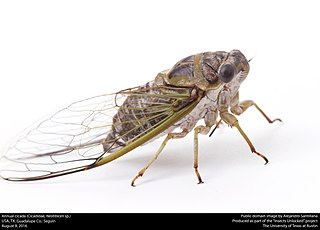
Cicadidae, the true cicadas, is the largest family of cicadas, with more than 3,200 species worldwide. The oldest known definitive fossils are from the Paleocene, a nymph from the Cretaceous Burmese amber has been attributed to the family, but could also belong to the Tettigarctidae.

Cicadas of the genus Neotibicen are large-bodied insects of the family Cicadidae that appear in summer or early fall in eastern North America. Common names include cicada, harvestfly, jar fly, and the misnomer locust. In 2015, these species were moved from the genus Tibicen, which was redefined in the twenty-first century to include only a few European species, while species from the Western United States and Mexico are now placed in a separate genus, Hadoa. In addition, several former Neotibicen species have been moved to the genus Megatibicen.
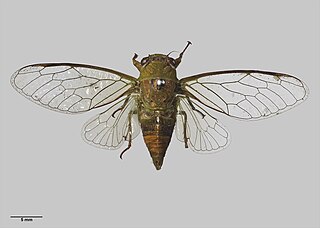
Kikihia is a genus of cicada in the family Cicadidae. Most species contained in the genus are endemic to New Zealand, with a single Australian species found on Norfolk Island. The genus was established in 1972 by John S. Dugdale with eleven species formerly classed within the genus Cicadetta.
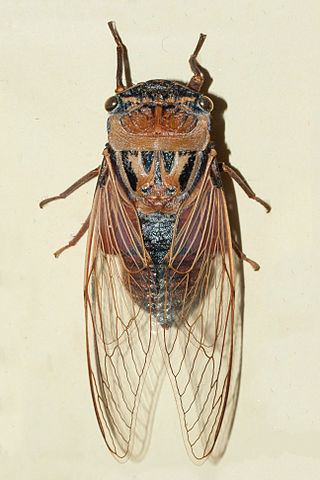
Thopha saccata, the double drummer, is the largest Australian species of cicada and reputedly the loudest insect in the world. Documented by the Danish zoologist Johan Christian Fabricius in 1803, it was the first described and named cicada native to Australia. Its common name comes from the large dark red-brown sac-like pockets that the adult male has on each side of its abdomen—the "double drums"—that are used to amplify the sound it produces.
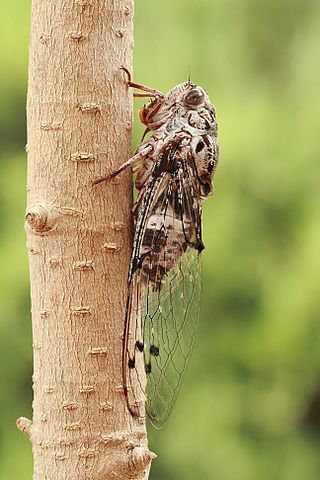
Aleeta curvicosta is a species of cicada, one of Australia's most familiar insects. Native to the continent's eastern coastline, it was described in 1834 by Ernst Friedrich Germar. The floury baker is the only described species in the genus Aleeta.
Platylomia is a genus of cicadas from Southeast Asia.
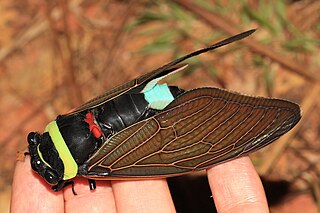
Tacua speciosa is a very large Southeast Asian species of cicada. It is the only member of the genus Tacua.

Zammara is a genus of cicadas. These species are large cicadas that are generally bright blue-green in color. Like other cicadas, these can produce loud calls; Zammara tympanum, for example, makes a "winding up-like pulsating buzz." Zammara are found in the Neotropics, especially in equatorial regions, where they live in tropical forest habitat. The genus is characterized by tarsi that are divided into 2 segments, or tarsomeres; other genera in the tribe have 3 tarsomeres in each tarsus.

Thopha sessiliba, commonly known as the northern double drummer, is an Australian cicada native to Queensland, the Northern Territory and northern Western Australia. Adults perch almost exclusively on ghost gums.

Euterpnosia is a genus of cicada native to the island of Formosa, the Ryukyu Archipelago, Japan, Hainan and mainland Asia - China, Bhutan, Nepal and Vietnam. The type species is Euterpnosia chibensisMatsumura, 1917. Until 2013 this genus was placed in the subtribe Leptopsaltriina, but is now considered typical of the Euterpnosiina Lee, 2013.
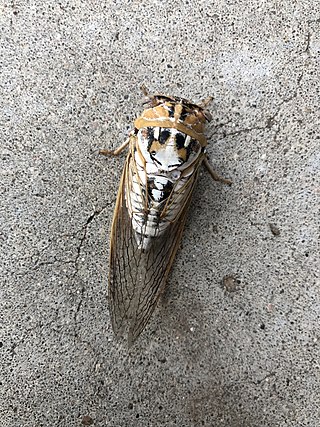
Megatibicen dealbatus, commonly called the plains cicada, is a species of annual cicada. Dealbatus is Latin for "whitewashed".

Purana tigrina is a species of cicada found in Southeast Asia. It was described from Malabar, South India. It is a common species in the Malayan Peninsula and on Bunguran Island in the South China Sea.

Chremistica ochracea is a cicada species of the genus Chremistica and suborder Auchenorrhyncha, which includes cicadas, leafhoppers, planthoppers, treehoppers, froghoppers and spittlebugs. They are usually referred to as 'thin winged cicada' in Taiwan and 'peaceful cicada' in China due to their abundance in these areas. They can be identified by their green appearance with thin, greenish, transparent wings and are heavily distributed in China, Taiwan, Japan, India and Malaya. However, there are limited number of scientific papers that describe the characteristics and behaviour of this species in detail.

Kikihia subalpina, commonly known as the subalpine green cicada, is a species of cicada that is endemic to New Zealand. This species was first described by George Hudson in 1891.

Dundubia is a genus of cicadas in the subfamily Cicadinae and the type genus of the tribe Dundubiini.
Dundubia spiculata is a species of cicadas in the tribe Dundubiini. The recorded distribution includes Indo-China and Peninsular Malaysia.
Flata is the type genus of planthoppers in the family Flatidae and tribe Flatini, erected by Johan Christian Fabricius in 1798. Species are recorded from subtropical and tropical Asia including India, China, Indochina and Malesia.
Illyria viridis, the yidiyidi, is a species of singing cicada found in Western Australia. The genus Illyria was created in 1985 by Australian entomologist Maxwell Sydney Moulds. The yidiyidi was first described by Moulds and David C. Marshall in 2022. Prior to 2022, the genus consisted of only four cicada species for almost forty years.
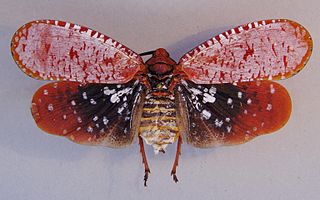
Aphaena submaculata is a species of planthoppers in the sub-family Aphaeninae of Fulgoridae. Species are distributed from eastern India, Indo-China, China and Malesia.
















